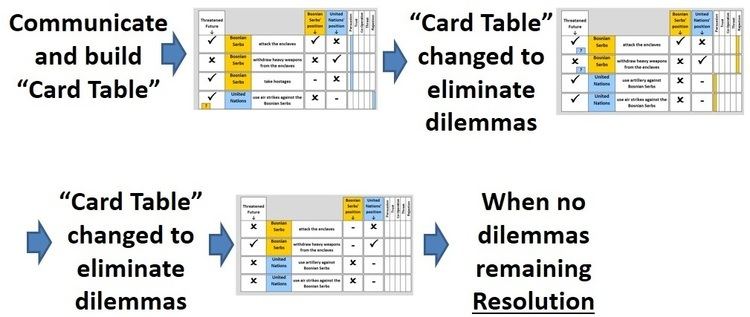 | ||
Confrontation analysis 9th july v2
Confrontation analysis (also known as dilemma analysis) is an operational analysis technique used to structure, understand and think through multi-party interactions such as negotiations. It is the underpinning mathematical basis of drama theory.
Contents
- Confrontation analysis 9th july v2
- Confrontation analysis 9th july v3
- Derivation and use
- Method
- References
It is derived from game theory but considers that instead of resolving the game, the players often redefine the game when interacting. Emotions triggered from the potential interaction play a large part in this redefinition. So whereas game theory looks on an interaction as a single decision matrix and resolves that, confrontation analysis looks on the interaction as a sequence of linked interactions, where the decision matrix changes under the influence of precisely defined emotional dilemmas.
Confrontation analysis 9th july v3
Derivation and use
Confrontation analysis was devised by Professor Nigel Howard in the early 1990s drawing from his work on game theory and metagame analysis. It has been turned to defence, political, legal, financial and commercial applications.
Much of the theoretical background to General Rupert Smith's book The Utility of Force drew its inspiration from the theory of confrontation analysis.
I am in debt to Professor Nigel Howard, whose explanation of Confrontation Analysis and Game Theory at a seminar in 1998 excited my interest. Our subsequent discussions helped me to order my thoughts and the lessons I had learned into a coherent structure with the result that, for the first time, I was able to understand my experiences within a theoretical model which allowed me to use them further
Confrontation analysis can also be used in a decision workshop as structure to support role-playing for training, analysis and decision rehearsal.
Method
Confrontation analysis looks on an interaction as a sequence of confrontations. During each confrontation the parties communicate until they have made their positions clear to one another. These positions can be expressed as a card table (also known as an options board) of yes/no decisions. For each decision each party communicates what they would like to happen (their position) and what will happen if they cannot agree (the threatened future). These interactions produce dilemmas and the card table changes as players attempt to eliminate these.
Consider the example on the right (Initial Card Table), taken from the 1995 Bosnian Conflict. This represents an interaction between the Bosnian Serbs and the United Nations forces over the safe areas. The Bosnian Serbs had Bosniak enclaves surrounded and were threatening to attack.
Each side had a position as to what they wanted to happen:
The Bosnian Serbs wanted (see 4th column):
The UN wanted (See 5th column):
If no further changes were made then what the sides were saying would happen was (see 1st column):
Confrontation analysis then specifies a number of precisely defined dilemmas that occur to the parties following from the structure of the card tables. It states that motivated by the desire to eliminate these dilemmas, the parties involved will CHANGE THE CARD TABLE, to eliminate their problem.
In the situation at the start the Bosnian Serbs have no dilemmas, but the UN has four. It has three persuasion dilemmas in that the Bosnian Serbs are not going to do the three things they want them to (not attack the enclaves, withdraw the heavy weapons and not take hostages). It also has a rejection dilemma in that the Bosnian Serbs do not believe they will actually use the air strikes, as they think the UN will submit to their position, for fear of having hostages taken.
Faced with these dilemmas, the UN modified the card table to eliminate its dilemmas. It took two actions:
Firstly, it withdrew its forces from the positions where they were vulnerable to being taken hostage. This action eliminated the Bosnian Serbs' option (card) of taking hostages.
Secondly, with the addition of the Rapid Reaction Force, and in particular its artillery the UN had an additional capability to engage Bosnian Serb weapons; they added the card "Use artillery against Bosnian Serbs". Because of this, the UN's threat of air strikes became more credible. The situation changed to that of the Second Card Table:
The Bosnian Serbs wanted (see 4th column):
The UN wanted (See 5th column):
If no further changes were made then what the sides were saying would happen was (see 1st column):
Faced with this new situation, the Bosnian Serbs modified their position to accept the UN proposal. The final table was an agreement as shown in the Final Card table (see thumbnail and picture).
Confrontation analysis does not necessarily produce a win-win solution (although end states are more likely to remain stable if they do); however, the word confrontation should not necessarily imply that any negotiations should be carried out in an aggressive way.
The card tables or are isomorphic to game theory models, but are not built with the aim of finding a solution. Instead, the aim is to find the dilemmas facing characters and so help to predict how they will change the table itself. Such prediction requires not only analysis of the model and its dilemmas, but also exploration of the reality outside the model; without this it is impossible to decide which ways of changing the model in order to eliminate dilemmas might be rationalized by the characters.
Sometimes analysis of the ticks and crosses can be supported by values showing the payoff to each of the parties.
